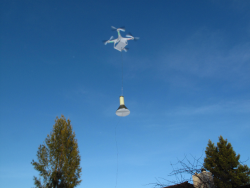n6gn
About
- Username
- n6gn
- Joined
- Visits
- 5,483
- Last Active
- Roles
- Member
- Points
- 31
-
VDSL2 interference what options have I got
If you use a broadband display, particularly one with min/max hold you can appreciate where the QRM is by the ham-band notch depths as well as how much it is hurting your SNR.
Here is capture of reverse channel, user ==> Internet, Internet-over-coax, QRM leaking from a neighbor of N6GN received on an RX888 and recorded with ka9q-web from ka9q-radio. Some of the ham band notches are IDed. The depth of the notch indicates how badly the SNR is being hurt by this interference.
This is being received by a 6m dipole SAS which has quite flat field response over these marked frequency range.
Because of the notches, ham band performance isn't being hurt but SWL and other listening at other frequency certainly is.
-
LZ1AQ Active Amp and a "Fat" Lazy loop - Dual Opposing Loops.
Don't confuse lower levels with lower SNR, which can sometimes happen. A properly operating loop should have ultimate performance very similar to a similar sized dipole probe, at least up through mid HF, modulo antenna pattern in az&el which can favor one or the other depending upon what you consider 'better'.
As LZ1AQ has written, making a small lowZ system reach propagated noise limits in the quietest locations may be impossible at the high end using components known-to-mankind as it is for small dipoles. But in general if/when all the other system noise ingress, noise floor, and IMD are pushed below the propagated noise produced within either antenna's radiation resistance the limits are very similar.
-
Quiet switch mode power supply (SMPS) for KiwiSDR
Getting rid of differential noise is fine, though the power management IC regulators in the Kiwi's BB is so good that this is seldom to never a problem, in my experience. (Try deliberately introducing differential noise and check the Kiwi's response. I haven't done this for a while but I think even 100 mV tends to be pretty invisible)
But just looking the schematic of this typical linear regulator and wondering ...
What would happen if we built a PS, either linear or SMPS and then added another series pass device in the 'GND' leg of the output to raise the impedance and reduce CM current? Against typical CM source/load impedances, would it significantly improve the situation in real circumstances?
It likely might not since typical total CM impedance may be in the 100's of ohms territory and well above the effective resistance of the series pass devices, but it wouldn't be difficult to try.
-
FT8 6m Autorun [fixed in v1.695]
I think the question was reasonable since it was "using down converters". For this reason using a frequency converter/extender such as the 0-2 GHz transverter I use here suggests the value of having many additional bands listed as options.
Amateurs have already made a great deal of use of narrow band modes above HF, particularly WSPR on 2m and shorter wavelengths.
6m FT8 is very active now in the Northern Hemisphere as we are in the midst of the sporadic E season. With the LO offset JKS has added, the KiwiSDR already natively supports all-modes on all-bands. Adding FT8 support and even all-extension support makes a lot of sense to me.
Why not support it all in a Kiwi?
-
Uncommanded 26 dB attenuation, SMA connector tightening
I worked in an HP microwave lab and as I remember the production line spec for torque was surprisingly low, only 7 inch-pounds. That was with quality connectors on the highest quality vector network analyzers as well as on swept signal sources. As time went on other connector types good to above 18 GHz came to the fore but I don't think they were tightened more.
As Martin suggests, it's very easy to over-tighten these beyond that specification thinking it will make things better. It probably will only make things worse.
Glenn n6gn




